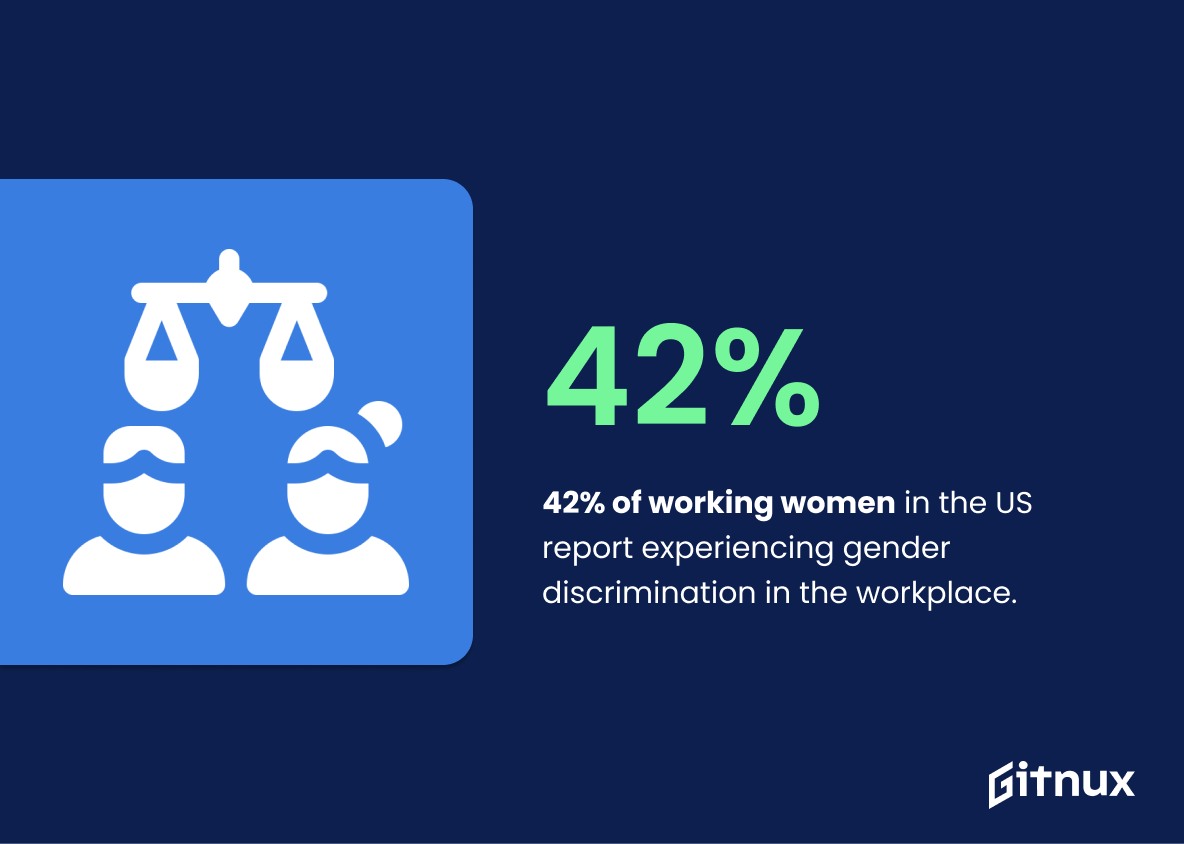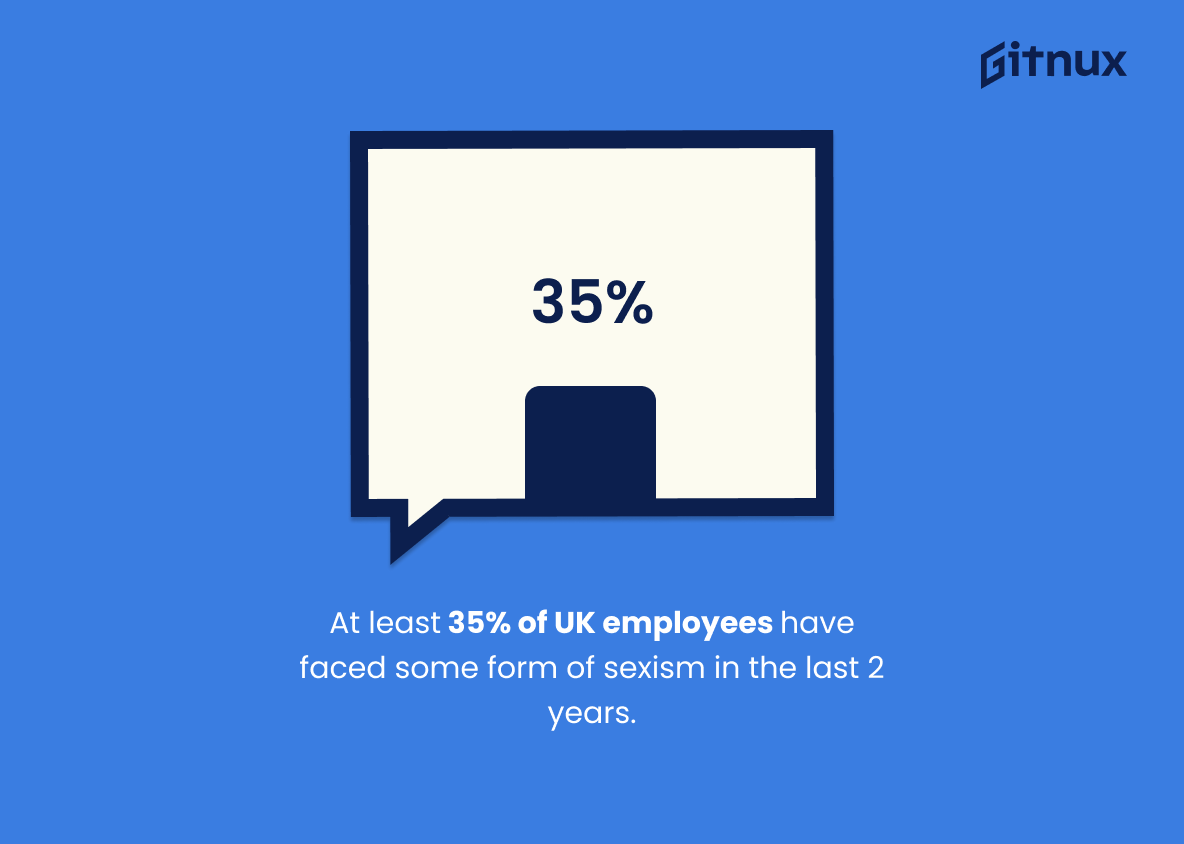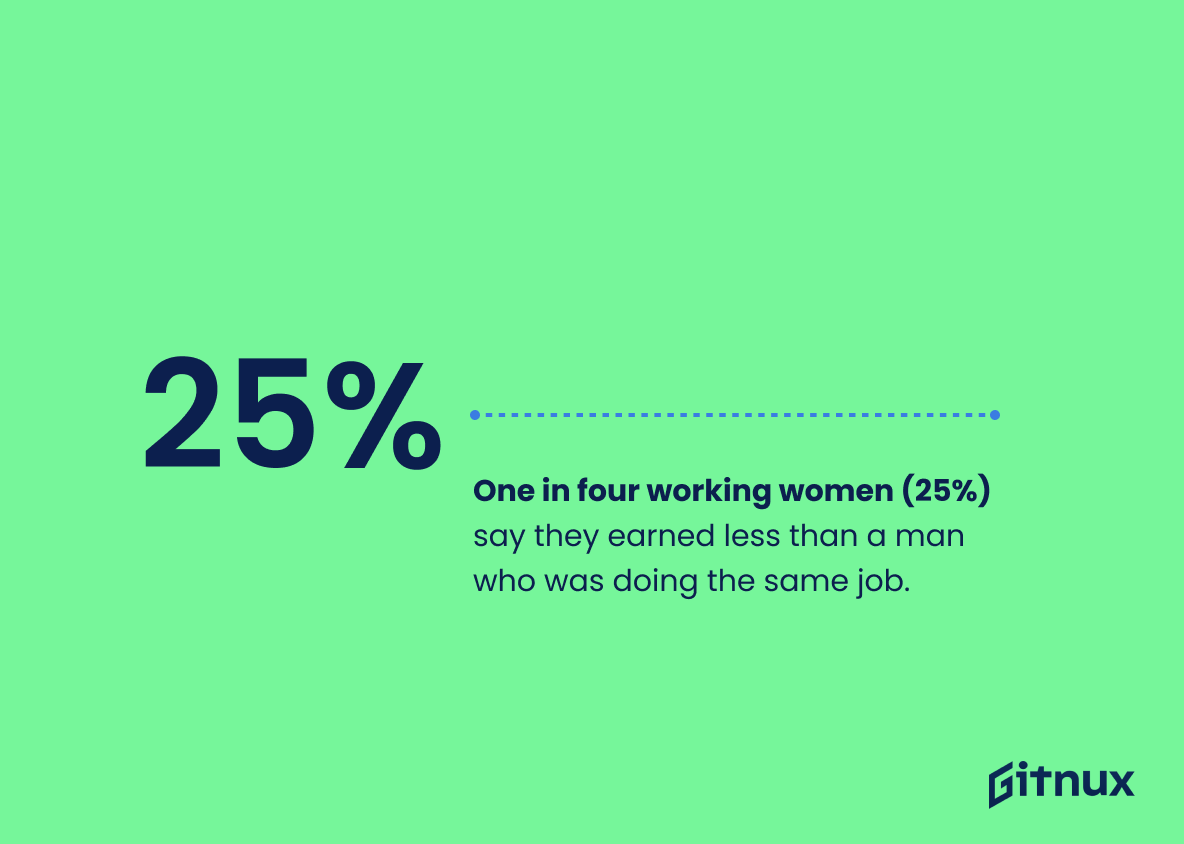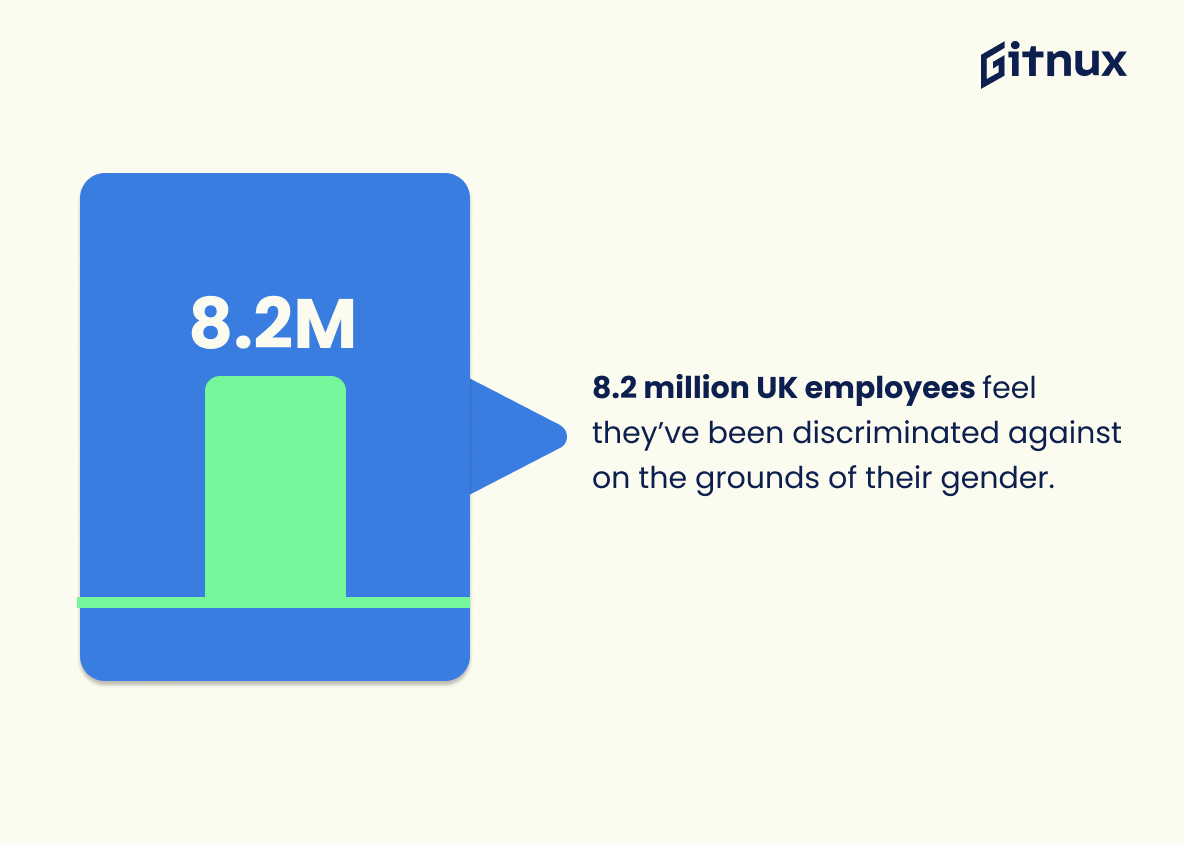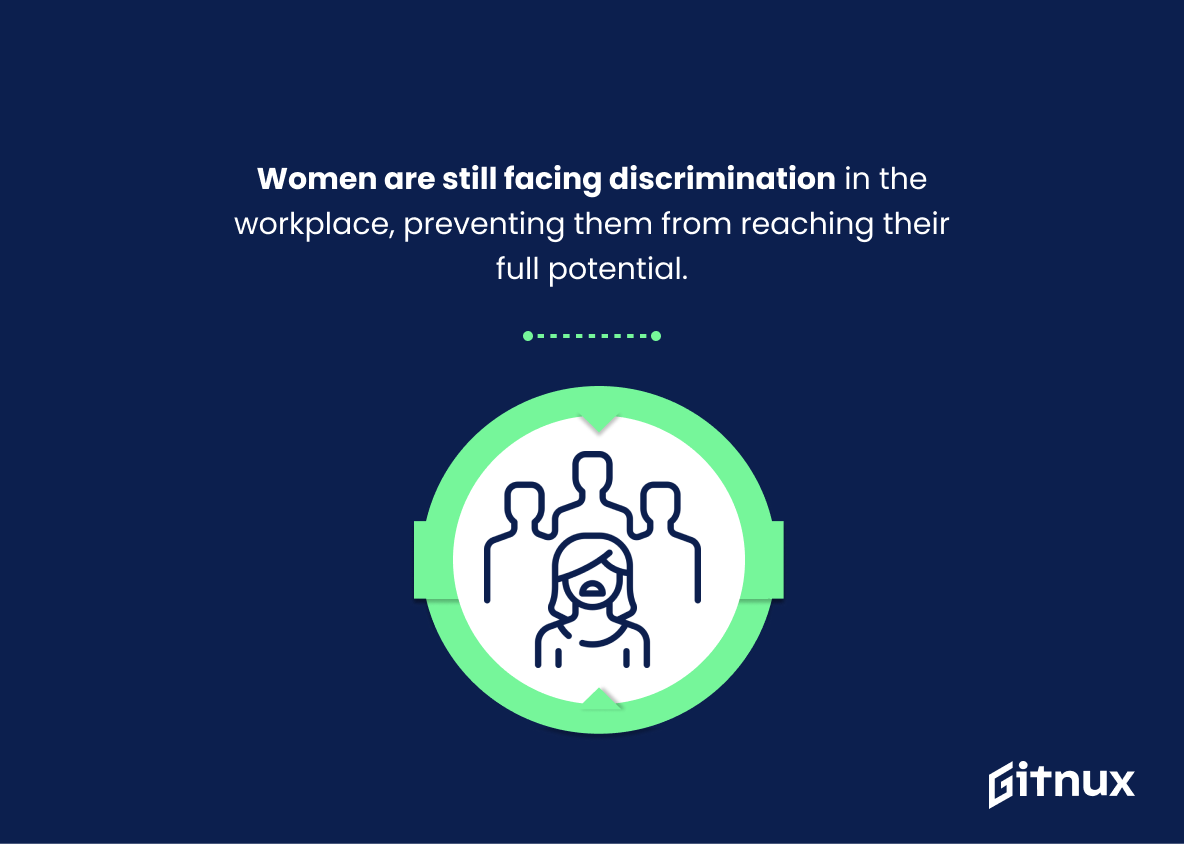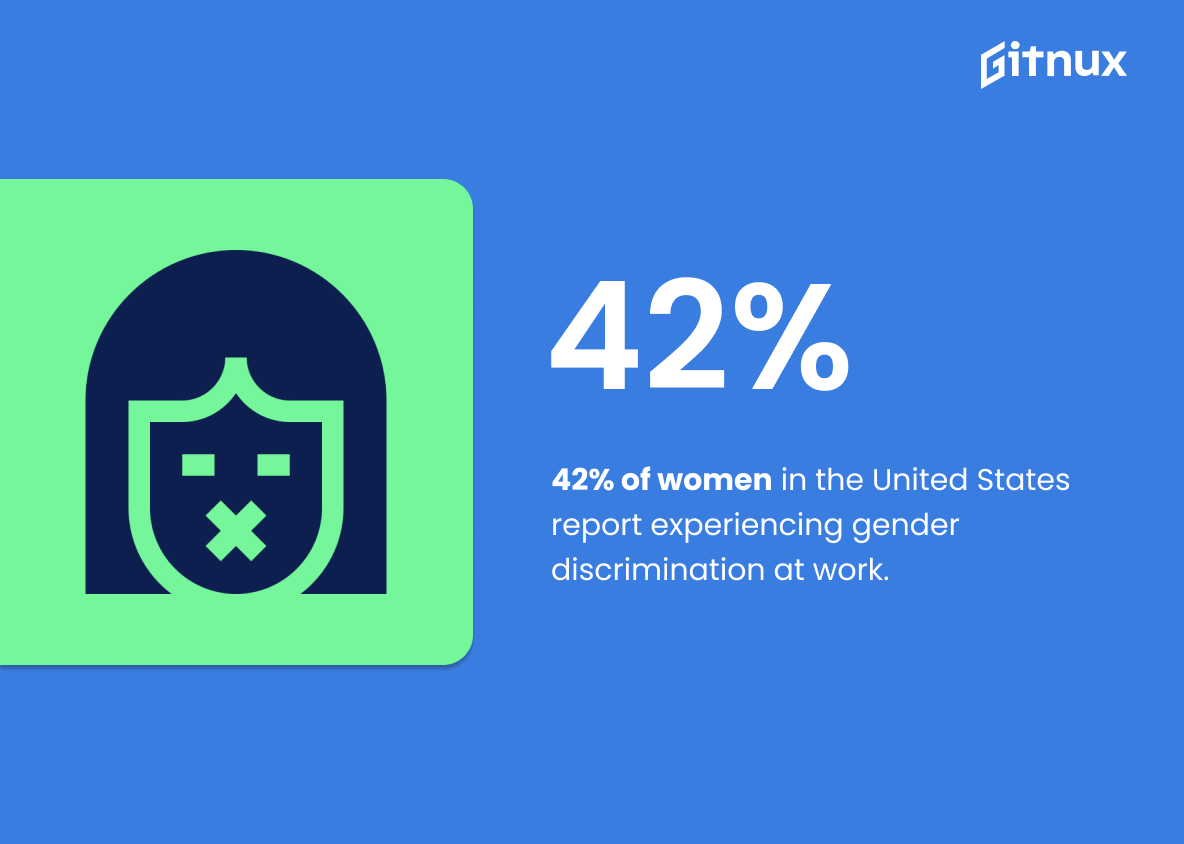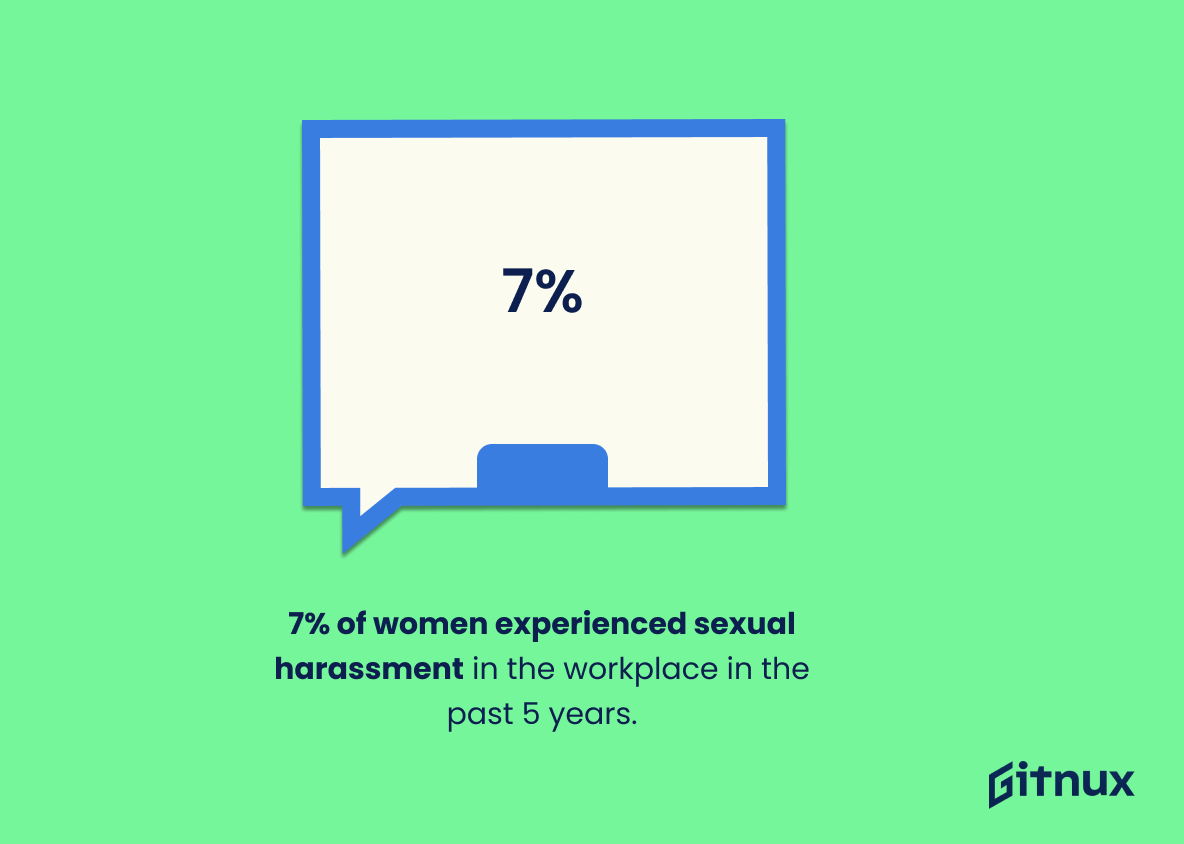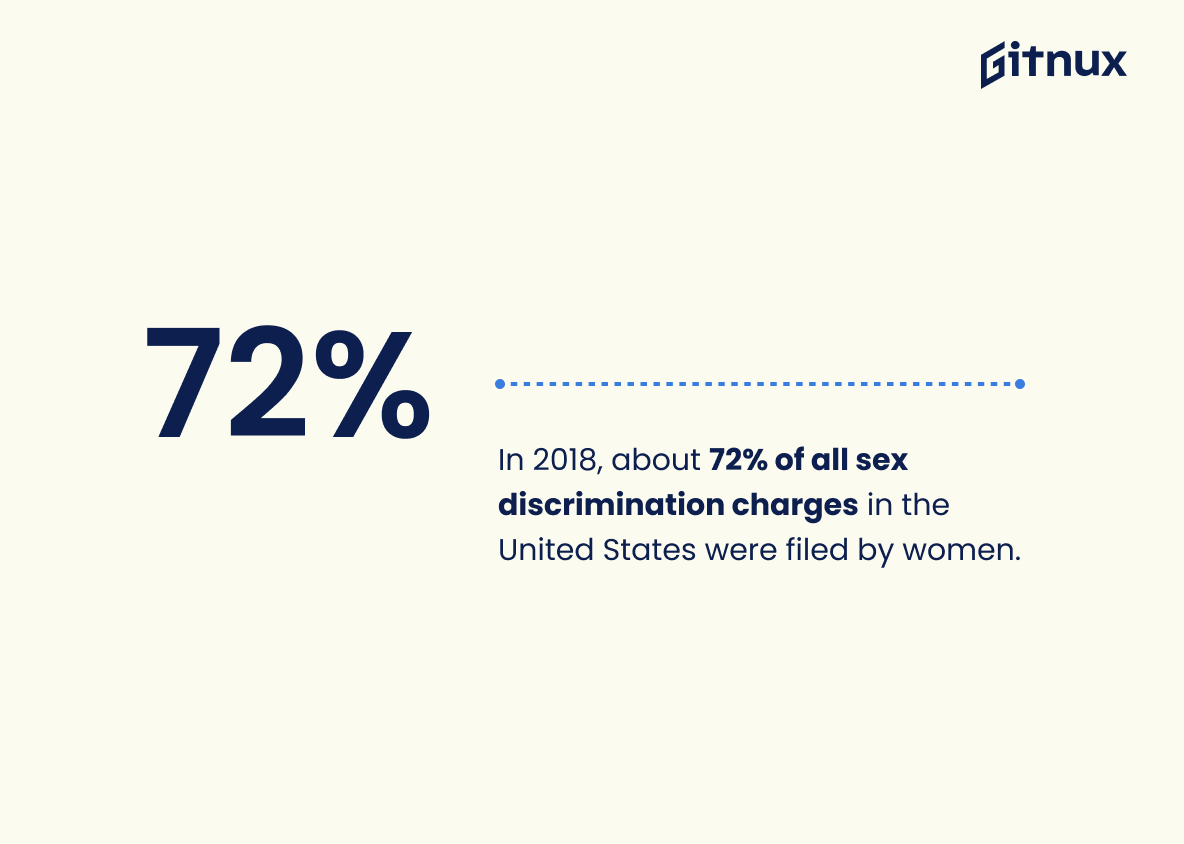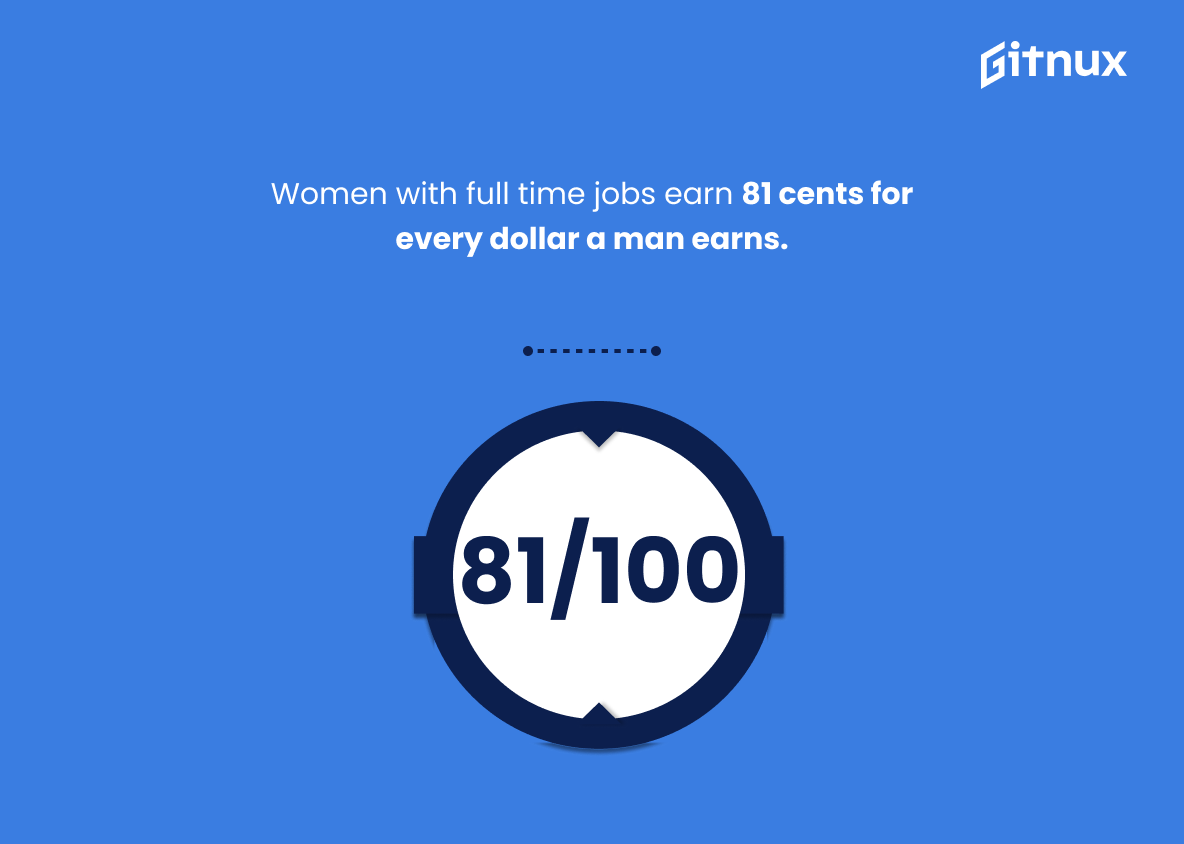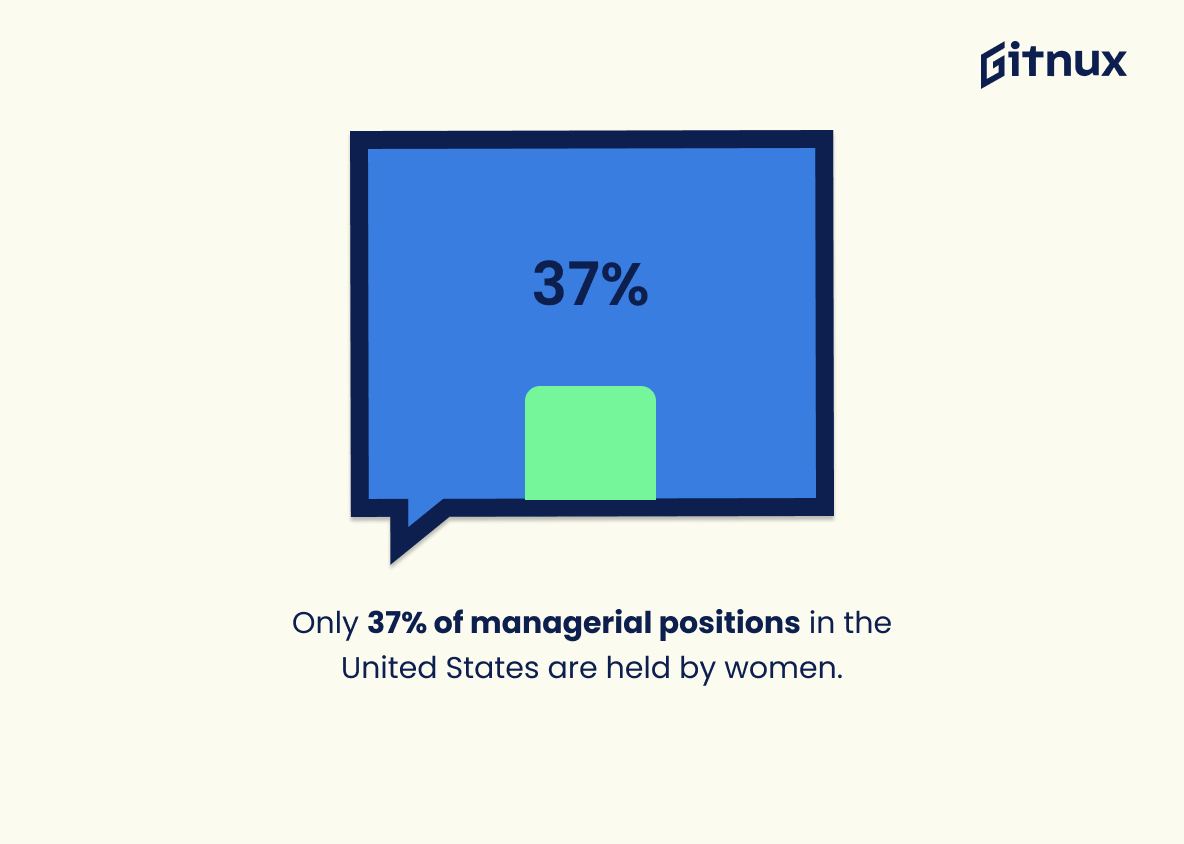In recent years, the issue of sexism in the workplace has become a hot-button topic. With the #MeToo movement gaining traction and more and more people speaking out about their experiences with workplace sexism, it’s clear that this is an issue that needs to be addressed. But what do the statistics say about sexism in the workplace?
In this blog post, we’ll take a look at the latest research and sexism in the workplace statistics to get a better understanding of the scope of the problem. We will also discuss what can be done to combat sexism in the workplace and create a more equitable environment for all.
Sexism In The Workplace: The Most Important Statistics
8.2 million UK employees feel they’ve been discriminated against on the grounds of their gender.
Over 75% of female founders in the technology industry reported experiencing sexism or sexual harassment in both 2017 and 2020.
Sexism In The Workplace: Statistics Overview
42% of working women in the US report experiencing gender discrimination in the workplace.
This statistic highlights the prevalence of sexism in the workplace and the need for further action to address this issue, and demonstrates the need for employers to create an environment that is free from discrimination and harassment. This statistic is a reminder that gender discrimination is still a problem in the workplace, and more needs to be done to ensure that everyone is treated fairly and equally.
At least 35% of UK employees have faced some form of sexism in the last 2 years.
The problem of sexism in the workplace is widespread, and it is not limited to certain industries or demographics. This statistic serves as a reminder that sexism is still an issue that needs to be addressed in the workplace and that employers need to take steps to ensure that their workplaces are free from discrimination and harassment.
Check out our latest Sexual Harassment In Workplace Statistics
One in four working women (25%) say they earned less than a man who was doing the same job.
It illustrates the gender wage gap that exists in many industries. Even when women are doing the same job as a man, they are still not receiving the same pay. This systemic inequality has a large impact on women’s financial well-being, their career prospects, and their ability to provide for their families. Additionally, it reinforces the idea that women are not as valued as men in the workplace, which can lead to other forms of gender discrimination.
Women are on average 30% less likely to be called for a job interview than men with the same qualifications. Gender bias in hiring statistics also indicate that almost 90% of men and women hold some sort of bias against women. Even though some countries are better than others, there’s still some form of gender inequality everywhere.
This statistic indicates that there is still a significant gender gap in hiring practices. Despite laws being in place to protect against discrimination in the workplace, bias against women still exists, and this is reflected in the fact that women are less likely to be offered job interviews than men with the same qualifications. This statistic is important because it serves as a reminder that there is still much work to be done in order to create a truly equitable and fair workplace for all genders.
Around 40% of men and women notice a double standard against female candidates in the digital marketing industry. Both women and men are more likely to hire men over women. Additionally, employers may place open positions on platforms with predominantly male candidates or actively target them with ads.
It means that, even when women are qualified and experienced candidates, they may be less likely to be considered or hired because of a gender bias that favors men. This statistic illustrates how deep-seated gender bias can be in the workplace and the need for employers to actively create more equitable hiring processes.
Gender bias is the tendency to prefer one gender over another, which can lead to unconscious stereotypes and attitudes that can affect how individuals interact with each other.
It can lead to unequal opportunities and treatment of individuals based on their gender, which can have a negative impact on their career and work environment.
Gender discrimination is the unequal treatment of individuals based on their gender, with women facing the most discrimination in the workplace.
It highlights the need for employers to be aware of and address gender bias in order to create a more equitable workplace.
8.2 million UK employees feel they’ve been discriminated against on the grounds of their gender.
This information highlights the prevalence of gender discrimination in the workplace. It also shows that gender discrimination is still a major issue in the UK, and that more needs to be done to address it.
Women are still facing discrimination in the workplace, preventing them from reaching their full potential.
This discrimination can lead to a variety of issues, including the gender wage gap, fewer opportunities for career advancement, and gender-based stereotyping. These issues can have a significant impact on women’s career prospects, and can lead to a lack of economic security and stability.
Over 75% of female founders in the technology industry reported experiencing sexism or sexual harassment in both 2017 and 2020.
It highlights the prevalence of sexism and sexual harassment in the workplace, particularly for female founders in the technology industry. It also shows that sexism and sexual harassment are more common experiences for women in the workplace. This highlights the need for further action to be taken to address sexism and sexual harassment in the workplace.
48% of women in Japan consider balancing work and caring responsibilities and unpaid work as the most prominent issues, while 40% consider sexual violence and sexual harassment as the most profound concerns.
This statistic shows the prevalence of gender-based issues in Japan, such as unequal pay, lack of access to childcare, and sexual violence and harassment. It also shows that women in Japan are facing a multitude of issues that are preventing them from achieving their full potential in the workplace.
42% of women in the United States report experiencing gender discrimination at work.
Gender discrimination is still a major issue in the United States, and that it affects a large portion of the female population. This statistic is an important piece of evidence that can be used to illustrate the need for greater awareness and action to combat sexism in the workplace.
7% of women experienced sexual harassment in the workplace in the past 5 years.
This highlighting the need for greater awareness and action to be taken to combat sexism in the workplace. It serves as a powerful reminder that sexism is still a major issue in the workplace, and that more needs to be done to ensure that all employees are treated with respect and dignity.
In 2018, about 72% of all sex discrimination charges in the United States were filed by women.
Women are disproportionately affected by discrimination in the workplace, and that this is an issue that needs to be addressed. It also serves as a call to action for employers to take steps to ensure that their workplaces are free from discrimination and that all employees are treated fairly and equally.
Nearly 50% of men believe that women are well represented in leadership positions.
Half of the male population is not only aware of the gender inequality that exists in leadership positions, but also that they recognize the lack of female representation in those roles. This is an important step in the right direction, as it shows that men are beginning to recognize the need for more female representation in leadership positions.
Women with full time jobs earn 81 cents for every dollar a man earns.
Women are still not receiving equal pay for equal work, and that sexism in the workplace is still a pervasive issue. This statistic is a powerful illustration of the need for greater gender equality in the workplace, and serves as a call to action for employers to take steps to close the wage gap.
Women of color hold only 17% of entry-level positions, compared to white men who hold about 36% of entry-level positions.
Women of color are disproportionately underrepresented in entry-level positions, while white men are overrepresented. This is a clear indication that women of color are facing greater obstacles in their pursuit of career advancement, and that sexism is still a major issue in the workplace.
25% of women feel they have missed out on opportunities for promotion because of their gender.
Gender inequality is still a major issue in the professional world, and that women are being denied the same opportunities as their male counterparts. This statistic is a call to action, and serves as a reminder that more needs to be done to ensure that women are given the same opportunities as men in the workplace.
57% of women in science, technology, engineering, and mathematics (STEM) have experienced gender discrimination.
This highlights the need for greater awareness and action to be taken to ensure that women in STEM are treated with respect and given equal opportunities. This statistic is a powerful reminder that sexism in the workplace is still a major issue and that more needs to be done to ensure that women in STEM are not subjected to discrimination.
Only 37% of managerial positions in the United States are held by women.
Women are still significantly underrepresented in managerial positions, and that sexism is still a pervasive issue in the workplace. This statistic is a powerful illustration of the need for greater gender equality in the workplace, and serves as a call to action for employers to take steps to ensure that women are given equal opportunities to succeed.
66% of human resources professionals report witnessing or dealing with a sexist incident at work.
Sexism is still a major issue in many workplaces, and that it is something that human resources professionals are having to deal with on a regular basis. This statistic is a powerful reminder that sexism is still a problem that needs to be addressed, and that it is something that should not be ignored or taken lightly.
Over 30% of women who have experienced gender discrimination in the workplace said it happened during the hiring process.
Gender discrimination is still a major issue in the workplace, and that it is not only limited to the workplace itself, but also extends to the hiring process. This statistic is a powerful reminder that sexism is still a major problem in the workplace, and that it is important to take steps to address it.
64% of women in the UK feel that gender discrimination is still an issue in their workplace.
Despite the progress made in recent years, gender discrimination is still a major issue for many women in the UK. This statistic is an important reminder that there is still much work to be done to ensure that all employees are treated fairly and equally in the workplace.
60% of working women in Europe believe sexism in the workplace negatively impacts their careers.
Sexism is still a major issue in the workplace, and that it is having a detrimental effect on the careers of many women. This statistic is an important reminder that sexism in the workplace is still a problem that needs to be addressed, and that it is having a real and tangible impact on the lives of working women in Europe.
Companies with higher diversity among management are 21% more likely to outperform others in profitability.
Companies that prioritize diversity in their management teams are more likely to experience greater success, proving that creating an inclusive environment is not only the right thing to do, but it can also be beneficial for business.
86% of women report experiencing sexist microaggressions, such as inappropriate comments or jokes, in the workplace.
Sexism is still a major issue in the workplace, and that it is not just a problem for a few isolated individuals. It also serves as a reminder that sexism is not just limited to overt acts of discrimination, but can also manifest in subtle, everyday microaggressions. This statistic is an important reminder that sexism is still a pervasive problem in the workplace, and that it needs to be addressed.
Female executives earn about 79% of what their male peers make in similar roles.
Sexism is still prevalent in the workplace, and that women are not being paid the same as their male counterparts for the same roles. This statistic is a powerful indicator of the need for change in the workplace, and serves as a call to action for employers to take steps to ensure that all employees are treated fairly and equitably.
Almost 90% of women working in tech have reported experiencing sexist behavior from male colleagues.
This highlights the need for greater awareness and action to be taken to ensure that women are treated with respect and given equal opportunities in the workplace. It also serves as a call to action for employers to take steps to create a more inclusive and equitable workplace environment for all employees.
Women who make up 33% of board members in CAC 40 (French stock market index) companies, only hold 16% of executive committee positions.
Despite making up a third of board members in CAC 40 companies, women are still significantly underrepresented in executive committee positions. This is indicative of a larger problem of sexism in the workplace, where women are not given the same opportunities as their male counterparts.
Australian companies with at least 30% female representation on their boards have 15% higher profitability than those without.
When women are given a seat at the table, it can lead to increased profitability for companies. This is an important reminder that sexism in the workplace is not only wrong, but it is also bad for business.
In Canada, the gender wage gap in private sector positions is 27.9%, compared to a 17.2% gap in public sector positions.
Even in a country like Canada, which is considered to be relatively progressive, there is still a significant wage gap between men and women in the private sector. This disparity is even more pronounced in the public sector, where the gap is almost 10% larger. This statistic is a powerful reminder that sexism in the workplace is still a major issue that needs to be addressed.
Conclusion
In conclusion, sexism in the workplace is a serious issue that needs to be addressed. The statistics show that women are still facing discrimination in the workplace, and that this discrimination is often based on gender. This is unacceptable and must be addressed in order to create a more equitable workplace.
Companies should strive to create a workplace that is free from discrimination and harassment, and that provides equal opportunities for all employees. By doing so, they can create a more productive and successful workplace.
References
1 – https://www.pewresearch.org/fact-tank/2017/12/14/gender-discrimination-comes-in-many-forms-for-todays-working-women/
2 – https://builtin.com/diversity-inclusion/gender-bias-in-the-workplace
3 – https://teamstage.io/sexism-in-the-workplace-statistics/
4 – https://writersblocklive.com/blog/sexism-in-the-workplace-statistics/
5 – https://www.smeloans.co.uk/blog/gender-discrimination-in-the-workplace/
6 – https://whattobecome.com/blog/gender-discrimination-in-the-workplace-statistics/
7 – https://cultivatedculture.com/sexism-in-the-workplace/
8 – https://www.statista.com/statistics/1218051/type-harassment-female-founders-global/
9 – https://www.statista.com/statistics/816227/japan-female-discrimination-issues/
10 – https://www.ciphr.com/workplace-discrimination-statistics/
11 – https://www.eeoc.gov
12 – https://www.hrdive.com
13 – https://www.computerweekly.com
14 – https://leanin.org
15 – https://aicd.companydirectors.com.au
16 – https://www.bls.gov
17 – https://www.statcan.gc.ca
18 – https://www.huffingtonpost.co.uk
19 – https://hbr.org
20 – https://www2.deloitte.com
21 – https://www.pewresearch.org
22 – https://www.independent.co.uk
23 – https://www.mckinsey.com
24 – https://www.charteredaccountants.ie
25 – https://www.ilo.org
26 – https://www.cnbc.com
